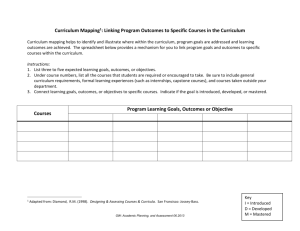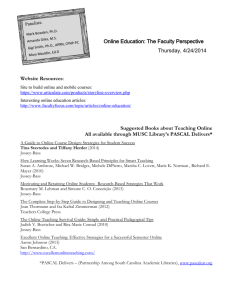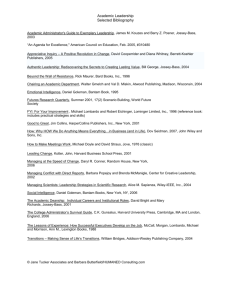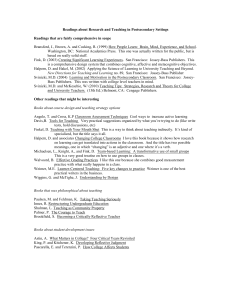CTCH 792 - George Mason University
advertisement
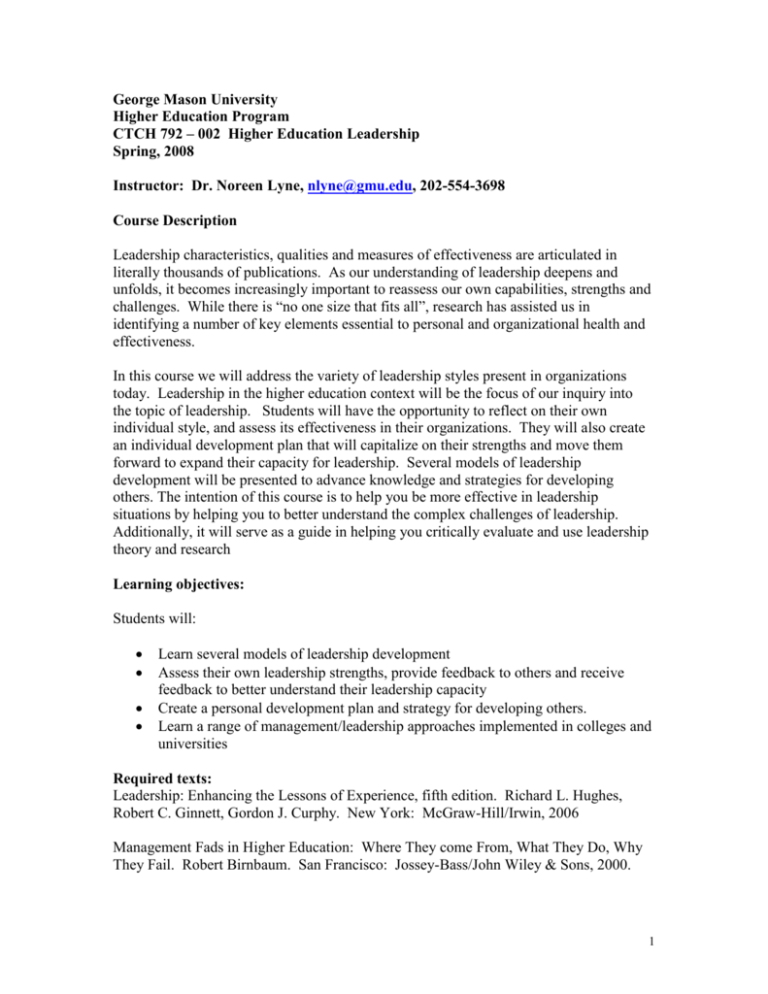
George Mason University Higher Education Program CTCH 792 – 002 Higher Education Leadership Spring, 2008 Instructor: Dr. Noreen Lyne, nlyne@gmu.edu, 202-554-3698 Course Description Leadership characteristics, qualities and measures of effectiveness are articulated in literally thousands of publications. As our understanding of leadership deepens and unfolds, it becomes increasingly important to reassess our own capabilities, strengths and challenges. While there is “no one size that fits all”, research has assisted us in identifying a number of key elements essential to personal and organizational health and effectiveness. In this course we will address the variety of leadership styles present in organizations today. Leadership in the higher education context will be the focus of our inquiry into the topic of leadership. Students will have the opportunity to reflect on their own individual style, and assess its effectiveness in their organizations. They will also create an individual development plan that will capitalize on their strengths and move them forward to expand their capacity for leadership. Several models of leadership development will be presented to advance knowledge and strategies for developing others. The intention of this course is to help you be more effective in leadership situations by helping you to better understand the complex challenges of leadership. Additionally, it will serve as a guide in helping you critically evaluate and use leadership theory and research Learning objectives: Students will: Learn several models of leadership development Assess their own leadership strengths, provide feedback to others and receive feedback to better understand their leadership capacity Create a personal development plan and strategy for developing others. Learn a range of management/leadership approaches implemented in colleges and universities Required texts: Leadership: Enhancing the Lessons of Experience, fifth edition. Richard L. Hughes, Robert C. Ginnett, Gordon J. Curphy. New York: McGraw-Hill/Irwin, 2006 Management Fads in Higher Education: Where They come From, What They Do, Why They Fail. Robert Birnbaum. San Francisco: Jossey-Bass/John Wiley & Sons, 2000. 1 Course Format: This course is presented in a seminar format with a combination of presentations and highly active participation of students in small groups. The course is scheduled for five week-end sessions. Reading assignments as well as class projects are expected to be completed in the periods between classes. In addition, ongoing dialogue on key issues and readings will be led by class members in class and on the web. As appropriate, guest speakers will bring relevant expert experience to the class dialogue. Requirements: students will engage in one on one and small group exercises that will provide a framework for assessing their own leadership style and understanding organizational dynamics. Students will keep a journal with reflections on the readings and their observations related to leadership. The journal work will be a key element in an integrative paper that addresses their personal development plan. The paper will also address recommended approaches for developing others. Individual student projects will address leadership paradigms and insights related to developing a high performing college/university organization. In addition to the texts, students will review relevant journal articles, actively participate in Webct discussions and complete a number of leadership assessment tools. Grading: students will be assessed on class engagement, demonstrated familiarity with the course materials, completion of an annotated bibliography, completion of the final integrative paper and the final class project Course Schedule and Reading Assignments Week-end #1 January 25, 26 Week-end #2 February 15, 16 Hughes, chapters 1 thru 4 Birnbaum, chapters 1 thru 4 Week-end #3 March 21, 22 Hughes, chapters 5 thru 8 Birnbaum, chapters 5 thru 7 Week-end #4 April 4, 5 Hughes, chapters 11 thru 13 Birnbaum, chapters 8 and 9 Week-end #5 April 25, 26 Hughes, part 5 2 Preliminary Bibliography Bennis, Warren (1995) On Becoming a Leader. Reading, MA: Addison-Wesley. DePree, Max. (1989). Leadership is an art. New York: Dell. Goleman, Daniel. (1995). Emotional Intelligence. New York: Bantam Books. Hughes, Richard L. , Robert C. Ginnett, & Gordon J. Curphy. (2002) Leadership: Enhancing the lessons of experience (4th ed.). New York: McGraw-Hill Irwin. Kouzes, James M. and Barry Z. Posner.(2002). The Leadership Challenge, Third Edition. San Francisco: Jossey-Bass. Jean Lipman-Blumen. (1966). The connective edge: Leading in an independent world. San Francisco:Jossey-Bass. Lombardo, Michael M. and Robert W. Eichinger. (2000). For Your Improvement. Minneapolis: Lominger Limited, Inc. George Manning and Kent Curtis.(2003). The art of leadership. New York: McGrawHill Irwin. McCall, Fr., Morgan. (1998). High flyers, developing the next generation of leaders. Boston, Massachusetts: Harvard Business School Press. Palmer, Parker. (1999). Let your life speak: listening for the voice of vocation. San Francisco: Jossey-Bass. Palmer, Parker. (1994). Leading from within: out of the shadows and into the light. In J.Conger(ed.) Spirit at Work. San Francisco: Jossey-Bass. Jon L. Pierce & John W. Newstrom. (2003). Leaders and the leadership process: Readings, self-assessments and applications (3rd ed.). New York: McGraw-Hill Irwin, 2003. Peterson, David B. & Hicks, Mary Dee. (1996). Leader as coach. Minneapolis, Minnesota: Personnel Decisions International. Terry, Robert. (1993) Authentic leadership: courage in action. New York: Jossey-Bass. 3 4


